

![]()
![]()
This Page:
Carola Baer-von Mathes
Jeanna Bauck
Hanna Bieber-Boehm
Hermine Biedermann
Paula Bonte
Helene Cramer
Molly Cramer
Clara Elizabeth Fischer
Fanny Geiger-Weishaupt
Elise Hedinger
Ernestine Hirschler
Dora Hitz
![]()
![]()
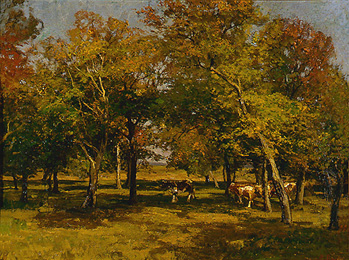
Autumn Landscape with Cows c. 1890--representative work.
Evening (image unavailable)--exhibited in Rotunda,
Woman's Building, 1893 Exposition.
Carola Baer-von Mathes was born in Ried im Innkreis, Austria. She married landscape painter Fritz Baer who had been her teacher, and she taught art at the Munich Ladies Academy. Some of her paintings were signed with the pseudonym C. Mathes. No further information is available online.
![]()

Danish Artist Bertha Wegman Painting
a Portrait--representative work.

Portrait--
representative work.

Portrait of the Countess
Pocci--representative work.
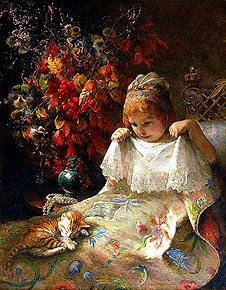
Girl with Cat in Bed--
representative work.
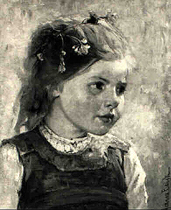
A Little Girl--
representative work.
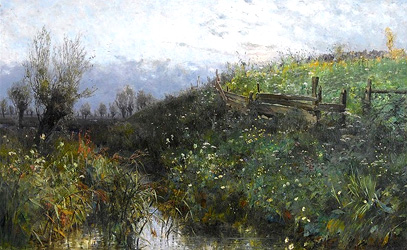
Summer Evening (Soir d'été)--
may
be the painting by that name that was exhibited
in the Rotunda, Woman's Building, 1893 Exposition.
Jeanna Bauck was born in Stockholm to a Swedish mother (Dorotea Hansson) and a German composer father (Wilhelm Bauck), and her early education was almost exclusively musical until she began studying art in Dresden (Adolf Ehrhardt), Dusseldorf (Albert Flamm), Munich (Joseph Brandt), and particularly in Paris (Dietrich Langko). Primarily a landscape painter influenced by the Barbizon school of painting, she traveled extensively to the Alps, the Black Forest, and seaside in search of subject matter, but she was also known for her portraits. Bauck and portrait painter Berthe Wegmann became close friends, sharing homes and studios in Munich and Paris. The two artists produced interesting paintings of each other in their roles as women artists. Later in her career, she established a painting school for female artists and subsequently taught at the Society of Berlin Women Artists painting school, her most famous pupil being, perhaps, Paula Modersohn-Becker.
![]()
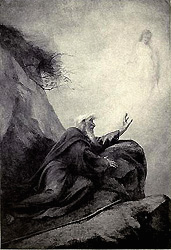
A Vision--might possibly be Ahasver, the Wandering
Jew (image unavailable)--exhibited in the Rotunda,
Woman's Building, 1893 Exposition
Hanna Bieber-Boehm was born in East Prussia into the large family of Otto Boehm and his wife. When her mother died, Hanna, as the eldest child, assumed mothering duties until she was in her early twenties and her widowed father re-married. Finally she was freed to study art with Snow, Gussow, and Saltzman in Berlin and then in Paris, Munich and Italy. Settling in Berlin, she was a member of the Association of Berlin artists and was also active as a writer. After her marriage to Jewish lawyer Richard Bieber, her interests turned mostly to social welfare and the women rights movement in which she played an active role. In addition to exhibiting at the 1893 Exposition, she was also part of the German delegation to the Women's Congress which met in the Women's Building at the 1893 World's Fair.
![]()

Collie chasing a Frog
--representative work.
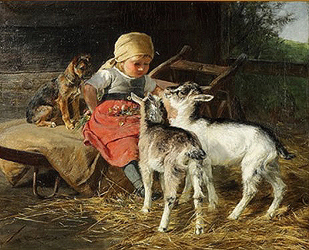
Young Girl with Dog and Goats
--representative work.

Hunting
Dog--
representative work.
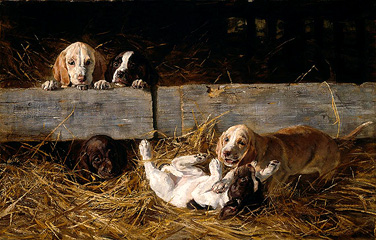
Puppies Playing
--representative work.
The First Booty (image unavailable)--
exhibited in Fine Arts Palace, 1893 Exposition.
Hermine Biedermann-Arendts was a German artist born in München. She studied under August von Heckel and Heinrich von Zügel and became the head of an art school for women. No other information is available online.
![]()
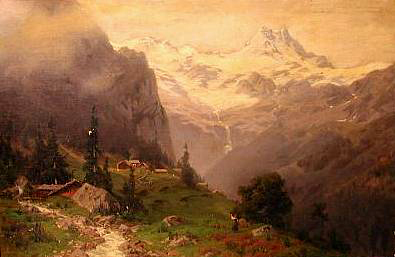
Mountain Lands (image unavailable)----representative work.
Chamonix, Switzerland (image unavailable)--exhibited
in Rotunda, Woman's Building, 1893 Exposition.
Paula Bonte was born in Magdeburg, Germany, and studied in Berlin under Eduard Pape and then under Otto Werner Henning von Kamecke, as well as in northern Italy, Switzerland, and northern Germany, all of which places were frequently shown in her paintings. No other information is available online.
![]()

A Flowering Branch
--representative work.

Flower
Still Life--
representative work.

Summer
Flowers--
representative work.
Clematis(image unavailable)--exhibited
in Fine Arts Palace, 1893 Exposition.
Roses (image unavailable)--exhibited
in Rotunda, Woman's Building, 1893 Exposition.
Forbidden to become artists by their father Cesar Cramer (a wealthy Hamburg merchant), Hélène Cramer and her sister Molly began studying art only after their father's death. First they studied with Hamburg artist Theobald Riefesell, followed by the painters Carl Rodeck and Hinrich Wrage. Then, in 1890, they went to Antwerp to train under Eugène Joors and came to the attention of the art gallery director Alfred Lichtwark who influenced Hélène to specialize in floral still lifes which she exhibited in Germany. No other information is available online in English.
![]()
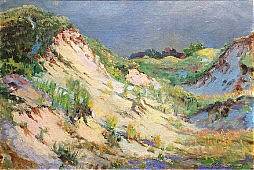
Dunes on
the Island of Sylt--
representative work.
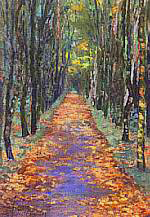
Birken Street
in Spring--
representative work.
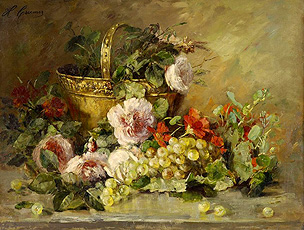
Still Life with Fruit and Flowers
--representative work.
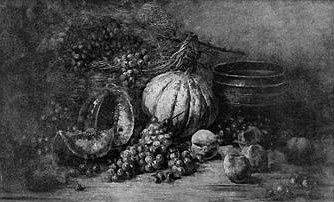
Fruit--exhibited in Rotunda, Woman's
Building, 1893 Exposition.
Peaches (image unavailable)--exhibited
in Fine Arts Palace, 1893 Exposition.
Forbidden to become artists by their father Cesar Cramer (a wealthy Hamburg merchant), Molly Cramer and her sister Hélène began studying art only after their father's death. First they studied with Hamburg artist Theobald Riefesell, followed by the painters Carl Rodeck and Hinrich Wrage. Then, in 1890, they went to Antwerp to train under Eugène Joors. Molly specialized in landscapes and portraits and enjoyed an international reputation. No other information is available online in English.
![]()

Friedrich Wilhelm III empfängt Achard
[1799 audience of Berlin chemist Franz Carl Achard
with the King] 1903--representative work.
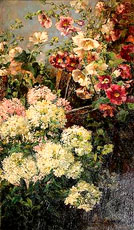
Malvern und Hortensien
vor Gartentor--
representative work.

Morning Prayer--exhibited in the Rotunda,
Woman's Building, 1893 Exposition.
Clara Elizabeth Fischer was born in Berlin and studied under Biermann and Julius Jacob. She specialized in portraits and genre subjects. No other information is available online.
![]()

Ein Vorfrhlingsmittag
auf der Hofgartenterasse
1894--
representative work.
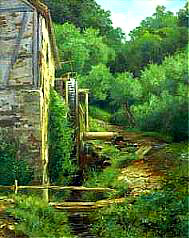
Frühlingslandschaft mit
Wassermühle am Bach--
representative work.

Hunting Company before a White Pavillion
--representative work.
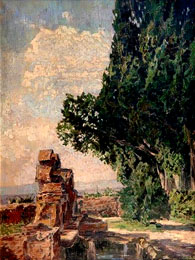
Summer Idyll--
representative work.
Landscape--Spring (image unavailable)--
exhibited in Fine Arts Palace, 1892 Exposition.
Fanny Geiger-Weishaupt was a German painter, born at Edenbergen near Augsburg. After her marriage to painter Viktor Weishaupt, a professor at the State Academy of Fine Arts in Karlsruhe, she studied with Karl Gebhardt at the Royal School of Applied Arts in Munich and privately with Ludwig von Herterich at Women's College of the Munich Artists Association, supplemented by study trips to France, Greece, the Netherlands, and Switzerland.
![]()
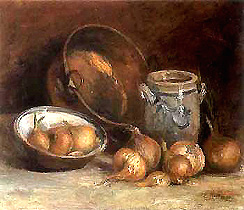
Still Life--
representative work.
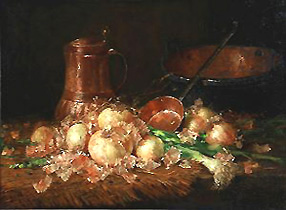
Onions and Leeks on a Table
1889--representative work.
Still Life (image unavailable)--exhibited in
Rotunda, Woman's Building, 1892 Exposition.
Elise Neumann Hedinger was born in Berlin into a merchant family. She studied art with Hoguet, Hertel, and Gussow in Berlin and with Bracht in Paris. "Hedinger" is her married name. (Note: The official Exposition records list her first name incorrectly as "Eliese.")
![]()
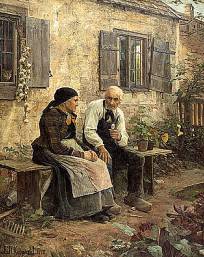
Lebensabend 1888--
representative work.
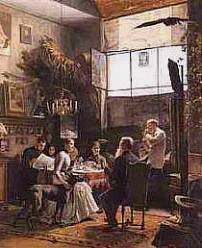
In the
Atelier--this picture
may be My Studio which
was exhibited in Fine Arts
Palace, 1893 Exposition.
Ernestine Hirschler-Kunwald was born in Munich to Jakob and Therese Kunwald and studied art with J. M. Aigner in Wien and later in München and Weimar where she evidently lived for the rest of her life. She married Adolf Edmund Hirschler and had two children, Georg and Marie. No other information is available online.
![]()
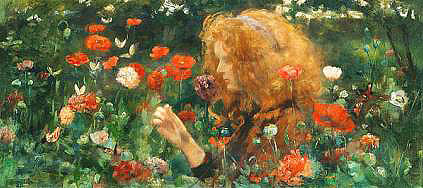
Girl in the Poppy-seed Field 1891--representative work.

Der Blumenkelch--
representative work.
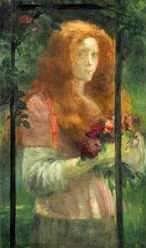
Dämmerüng [Twilight]--
representative work.

The Sun Child--
representative work.
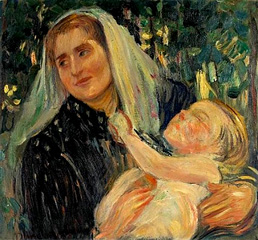
Mother and Child--This may or may
not be the "Mother and Child" work
exhibited in the Rotunda, Woman's
Building, 1893 Exposition.
Dora Hitz was born at Altdorf, near Nuremberg, and studied art with Lindenschmit at a women's art school in Munich and later, in Paris, with Merson, Courtois, Constant, and Carriere. At the request of the Queen of Romania, she went to Bucharest and created illustrations for the Queen's poem "Ada." Later in Berlin , she focused on portraits and founded a women's art school in 1894. Hitz was a co-founder of the modern group of painters called the Berlin Secession. After her death, her "Dämmerung" painting was seized by the Third Reich and later impounded by the East German authorities.
![]()
![]()
Go to German Women Painters, p. 2
Return to Women Painters Index
Return to Site Index
![]()
![]()
Text written by K. L. Nichols
Painting, top of page: Marie Konstantinovna
Bashkirtseff,
In the Studio (1881).
Return to Nichols Home Page
Suggestions/Comments: knichols11@cox.net
Posted: 6-25-02; Updated: 5-23-19